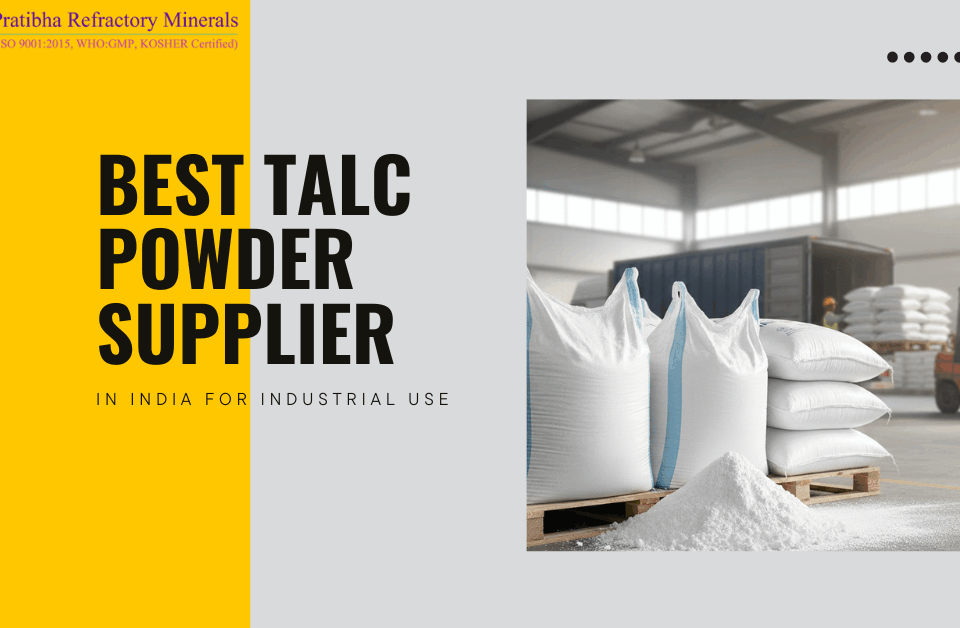- Call for Sales Enquiries

- +91-9413034047
- +91-294-2413244
- info@pratibharefractory.com
What Factors Influence the Pricing of Talc Powder Suppliers?

What Factors Influence the Price of Quartz Powder?
May 6, 2024
What Are the Different Applications of Dolomite Powder?
June 5, 2024What Factors Influence the Pricing of Talc Powder Suppliers?

Pratibha Refractory Minerals is a leading supplier of talc powder, offering high-quality products for various industries. With a commitment to excellence and customer satisfaction, we provide reliable talc solutions worldwide.
Quality of Talc:
Talc Powder may be found in varying grades depending on factors such as purity, particle size remaining the same, and the absence of impurities. But the higher quality talc, sometimes referred to as pharmaceutical or cosmetic grade, takes a further processing step that must comply with the industry standards, so it is usually used in cosmetics or medicine, and thus commands a premium price compared to lower grade talc that is used in industrial applications.
Supply and Demand:
The sharing of the supply of talc powder from mining services and the bids from many industries persists in the value of this product. The situation of rising prices can be caused by the fact of higher demand than supply, which, in turn, may be explained by the increase of the usage in cosmetic or pharmaceutical industries or the decline of the production and transport chains. On the contrary, if oil is being produced in surplus, then the prices will be lower.
Production Costs:
Expenses connected with mining, processing and transportation of talc powder are predominant cost drivers in establishing the final price range for talc powder. Mining operations are an investment that involves the purchase of machines, including labour. Safety measures are also cost incurrence of the mining activities. Talc goes through an energy-intensive process which includes finely grinding, to become powder. Not to be last, transportation costs which in case talc needs to be transported over long distances as well, can be a factor that influences the price.
Market Competition:
Having various suppliers available can bring competition in the market and an outcome of such competition may be a decrease in prices. Competitors, for example, may reduce prices via discounts, and/or launch new products, thereby attracting the attention of consumers. Hence, suppliers in the market might precociously alter their prices to maintain their attractiveness and profitability in the market. The worst starts when price competition may reach the highest level among those markets for talc powder containing no different factors between brands.
Geopolitical Factors:
Thousands of tons of talc are being mined in various parts of the planet while countries like China, the US, Brazil and India are the major sources of this mineral. Political uncertainty or trade disputes in these areas can impede supply chains in the market, which results in price fluctuation. i.e., some of the factors that could add to the cost of importing raw talc powder include the trade relations between the main producing nations and their importing counterparts, among others.
Currency Exchange Rates:
Talc powder trades globally, so its pricing in a local market is affected by the change in currency exchange rates. The strong currency in the country where the talc is produced may mean the exports would be more expensive for foreign buyers possibly resulting in the prices increasing in importing countries as well as the opposite occurring
Regulatory Environment:
Bylaws on extraction procedures, environmental safeguards, worker care, and product norms can affect the cost of making talcum powder. A flexible set of rules may require preventive measures like the purchase of new equipment, the introduction of safety measures or environmental repair, which will subsequently lead to an increase in production and pricing.
End-User Industries:
The demand for talcum powder fluctuates across industries broadly divided into cosmetics, pharmaceuticals, plastics, ceramics and paper. Disruption of consumer behaviour, technological achievements, and adjustments in regulatory provisions, all contribute to the turbulence of demand, and subsequently, to prices.


